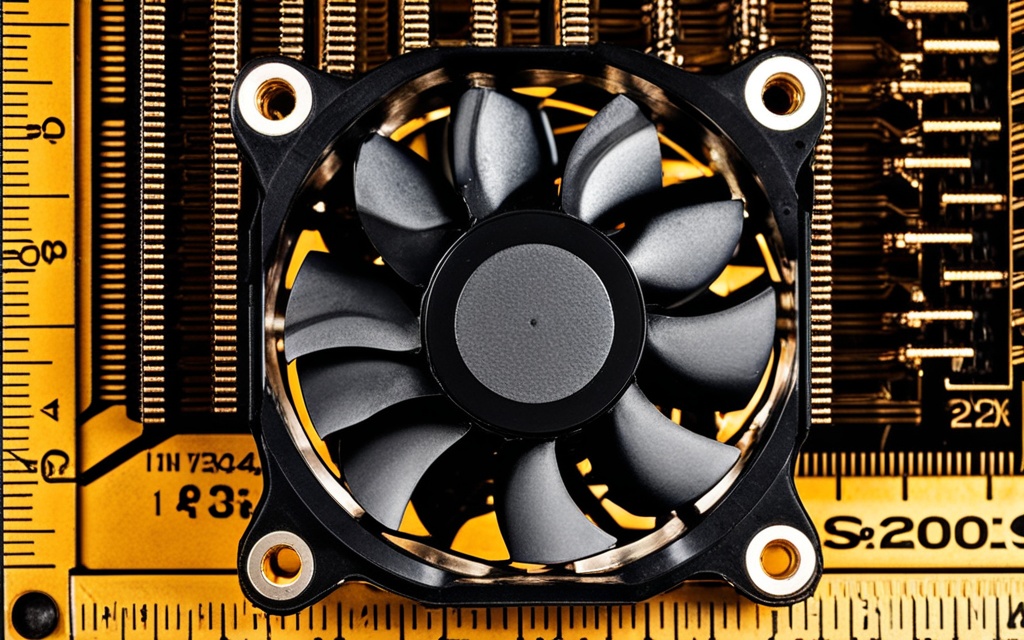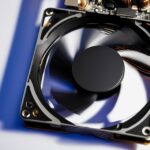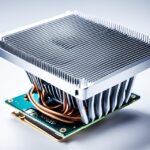Table of Contents
Measuring CPU fan dimensions accurately is crucial if you want to boost your computer’s cooling performance. Whether you plan to replace your CPU fans, or simply want to make them work better, knowing the right way to measure them is key. Fans come in different sizes, such as 80mm, 92mm, 120mm, and 140mm.
The usual size for a 140 mm fan is 14 cm from one edge to the other. The distance between the holes for mounting is about 12.5 cm1. It’s important to pick a fan that fits well, as this can make your computer cooler and work more efficiently. This helps protect your CPU when you’re doing intense computer tasks2.
Discovering the right fan size and measurements can make a big difference. It can lead to your computer performing better and lasting longer.
Key Takeaways
- Understanding CPU fan dimensions is crucial for optimal cooling.
- Common sizes include 80mm, 92mm, 120mm, and 140mm.
- Accuracy in measurement ensures compatibility and enhances performance.
- Properly sized fans can improve airflow efficiency.
- Various factors, including mounting mechanisms, affect fan performance.
Understanding CPU Fan Sizes
Choosing the right CPU fan is key for keeping your PC cool and running smoothly. Knowing about CPU fan sizes helps cooling systems work better. When you know fan dimensions, you can pick the perfect ones for your computer case.
Common Fan Sizes and Their Dimensions
Today’s market offers a variety of common fan sizes. Here are the key sizes:
- 40mm
- 60mm
- 80mm
- 92mm
- 120mm (the most common size)
- 140mm
- 200mm to 220mm
Standard case fans, for example, are often found in sizes like 92, 120, and 140mm3. A 120mm fan actually has a blade diameter of 110mm. Its mounting holes are spaced about 105mm apart4.
Why Size Matters for Cooling Efficiency
The fan size directly impacts how well it cools. Bigger fans, like the 200mm or 220mm ones, can push more air. This means they are great at keeping high-performance systems cool. High-end PCs and modern graphics cards, which can use up to 350 watts, may need their own big fans for cooling3.
Even memory modules and voltage regulators might require smaller fans to stay cool3.
Different fan types, like axial, centrifugal, and crossflow, offer unique advantages3. This affects how well a system can cool down3. Choosing the right size and type of fan is very important for anyone building or upgrading a PC.
Preparing to Measure Your CPU Fan
Before you start measuring your CPU fan, make sure to get the right tools for measurement. Also, it’s important to take the right security precautions. This preparation makes the process smoother and increases the chance of an accurate CPU fan measurement.
Essential Tools for Accurate Measurement
To measure the size of your CPU fan correctly, you need certain tools:
- Digital calliper or measuring tape (preferably in millimetres for precision)
- Notebook for recording measurements
- Compressed air for cleaning any dust and debris around the fan before measurement
- Safety goggles to protect your eyes from dust particles during the process
Using these tools for measurement will help you get accurate readings easily.
Safety Precautions to Consider
Before you measure your CPU fan, make sure to follow specific safety precautions. These are important:
- Ensure the computer is powered down and unplugged from the mains to avoid electric shock.
- Be careful with sharp fan blades to avoid injuries during the measurement.
- Wear clothes that won’t get caught in moving parts for safety.
By taking these safety precautions, you can lower the risk of accidents. Remember, doing regular checks and keeping your CPU cooler clean is vital. It ensures it works well and stops overheating. Learn more about maintaining your CPU cooler.
How to Measure CPU Fan Dimensions
Understanding how to measure CPU fan dimensions is key to making sure it fits well and works efficiently in your system. This guide will help you understand the important aspects of fan measurement. This makes installing the fan much easier.
Measuring Edge-to-Edge Dimensions
Measuring your CPU fan from one edge to the other is simple. This width is vital as it decides if the fan will fit your case. The most common fan sizes are 120 mm and 140 mm. These sizes are widely used in desktop computers5.
Determining Mounting Hole Spacing
Then, check the spacing between the mounting holes. The space between these holes is key for a secure fit. A 140 mm fan usually has hole spacing of about 124.5 mm. Getting this measurement right helps you pick the right fans and avoid fitting problems.
Understanding Fan Thickness
It’s also important to look at fan thickness. Most CPU fans are 25 mm thick. However, there are thinner options for special needs. Knowing the thickness of the fan helps you find the right replacements. Fans differing in thickness and blade design can meet various cooling requirements. This affects how efficient they are6.
| Measurement Type | Description | Common Examples |
|---|---|---|
| Edge-to-Edge | Width of the fan measured across opposite edges. | 120 mm, 140 mm |
| Mounting Hole Spacing | Distance measured between screw holes for secure installation. | 124.5 mm for a 140 mm fan |
| Fan Thickness | Depth measurement of the fan’s body influencing airflow. | Standard is 25 mm |
Knowing these measurements helps you make smart choices when it’s time to select or replace your CPU fan. This ensures your system gets the best cooling and airflow5.
Choosing the Right Replacement Fan
When picking a new fan, you need to look at more than just size. Many factors affect how well it will work in your system. It’s crucial to consider these factors for fan selection to ensure your cooling needs are met.
Factors to Consider Beyond Size
The demand for replacement fans is high, thanks to extra fan spots in many PCs today7. Fans range from small sizes like 70mm to bigger ones up to 230mm7. The 120mm fan is popular for its good balance between moving air and being quiet. It’s important to look at a fan’s air flow (CFM) and how loud it is (dBA). The best fans move a lot of air without making too much noise.
Static Pressure vs Airflow Performance
Fans are designed either for static pressure or for moving air efficiently. Static pressure fans are better at pushing air through tight spots, like radiators7. Airflow fans work best in open spaces where lots of air needs to be moved. You need to pick a fan that matches your system’s cooling demands. Remember, the balance between intake and exhaust fans is key to maintaining the right pressure inside your case. Also, check the fan connector type to ensure it fits your motherboard7.
Conclusion
Mastering how to measure a CPU fan is crucial for improving computer cooling. Knowing the right size and how to measure well helps you find better fans. This boosts airflow and keeps the system running smoothly. Good cooling stops overheating and makes computer parts last longer.
When picking fans, consider their pressure, airflow, and how loud they are. Each factor leads to a cooler system that meets your needs. By using certain tools, like the ones in this guide, you can keep an eye on important temperatures. Acting early on these readings prevents overheating issues. Such steps ensure your computer performs well for a long time.
It doesn’t matter if you use your computer a lot or a little, paying attention to fan measurement is key. Following these tips not only boosts your system’s performance but also keeps it quiet and efficient. This leads to a better and more eco-friendly computer setup89.
FAQ
How do I measure my CPU fan dimensions accurately?
To measure your CPU fan dimensions accurately, use a digital calliper. Measure the fan’s width from one side to the other. Also, check the space between the screw holes by measuring their distance.
What are the common CPU fan sizes available?
Common CPU fan sizes include 40mm, 50mm, 60mm, 80mm, 120mm, and 140mm. It’s vital to know these sizes to pick the right fan for your PC.
Why is it important to choose the right size CPU fan?
Choosing the right CPU fan size is key for effective cooling. Larger fans move air better, helping keep your system cool. They must also fit your PC case.
What precautions should I take before measuring my CPU fan?
Before you measure your CPU fan, make sure your computer is off and unplugged. Watch out for sharp edges and moving parts to avoid getting hurt.
How do I determine the airflow and static pressure of a fan?
Airflow is shown in cubic feet per minute (CFM), which tells you how much air a fan moves. Static pressure, shown in mm-H2O, indicates how well a fan can push air through tight spaces. Both are crucial for choosing a fan for your needs.
What should I consider when replacing a CPU fan?
When replacing a CPU fan, think about its size, airflow, and static pressure. Also, consider how loud it is (dBA) and if it fits with your cooling needs. Finding the right balance of these factors helps you pick the best fan.
Source Links
- https://voltcave.com/measure-pc-fan/ – How to Measure a PC Fan’s Size: A Quick Guide – Voltcave
- https://softwareg.com.au/blogs/computer-hardware/how-to-know-if-cpu-fan-will-fit – How To Know If CPU Fan Will Fit
- https://en.wikipedia.org/wiki/Computer_fan – Computer fan
- https://www.titanrig.com/blog/post/water-cooling-components-fans – PC Case Fans – Function and Considerations | TITAN RIG Blog
- https://www.akyga.com/news-list/86-computer-fan-a-guide-to-sizes-and-types.html – Computer fan – a guide to sizes and types
- https://www.corsair.com/us/en/explorer/diy-builder/fans/pc-fans-static-pressure-vs-airflow/ – Fans: Static Pressure vs Airflow
- https://www.pcworld.com/article/440443/how-to-install-or-replace-a-case-fan.html – How to install (or replace) a case fan
- https://www.10-strike.com/network-monitor/pro/cpu-temperature-monitoring.shtml – How to Monitor Temperature of CPU, GPU, and Fan Speed on Computers over the Network
- https://www.electronicshub.org/cpu-fan-speed/ – How To Control CPU Fan Speed?








